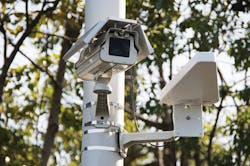MicroPower Technologies, a San Diego-based provider of wireless, solar-powered surveillance solutions, announced on Monday that it has secured $5.7 million in new funding from investors. According to MicroPower CEO Aaron Tankersley, this funding will help the company accomplish several goals including commercializing its’ existing technology and also investing in new products.
“Really the main purpose (for this funding) is investing in follow-on and expanded product lines. We’re not announcing a new product line yet, but the capital is being put into engineering and R&D to really build on the existing capabilities that we’ve been displaying,” Tankersley explained. “The company is in a good position and the capital reinforces the commitment that both MicroPower and its’ investors have to this particular industry and sector, as well as the technology we’ve developed.”
Tankersley said that the company will be looking into a variety of improvements to its product line including adding day/night capabilities to its cameras. However, he also indicated that everything they do will focus on remaining “ultra-low” power and building on their current advantage in the market. Tankersley said that MicroPower surveillance products currently draw 10 percent less power than their competitors.
The company markets its cameras as being a viable alternative to trenching, which can be a costly proposition for organizations that need to have video surveillance in areas that are either remote or are difficult to run traditional power and communications infrastructure to.
“I think (the surveillance) industry is a prove it-type industry, which is something that we’re now able to do is to prove that it works in a range of environments and I think that is what the industry expects and wants to see is ‘show me it works,’” Tankersley said. “Once we’ve seen that happen, we’ve seen a high-level of acceptance by the industry once they see that the technology works and a lot of folks understand what the value proposition is. Now that we’re demonstrating commercial success, as well as robustness of the technology across a wide range of environments, we’re seeing a lot of enthusiasm for our product.”
Despite the obvious financial benefits of avoiding trenching, MicroPower’s wireless and solar-powered cameras also help end users be more environmentally conscious, which is important in several vertical markets.
“The green side of it really plays into some of the municipalities for their own constituents and citizens. They like that aspect that it’s solar,” Tankersley explained. “For larger companies, it is much more about the pure return on investment they see around hard economic numbers, but some of the municipalities have been enthusiastic about the green aspects.”
Among some of the vertical markets that MicroPower has seen success in include university campuses, military bases, and the freight and transportation sector.
“The product I would say has been kind of commercially stable and viable very recently,” Tankersley said. “We did our second generation release at the end of 2012, worked out a couple of bugs earlier this year and now it is a very stable platform that we can build on in 2013. While the company is five years old, this is a very challenging engineering problem, so from a product maturity point-of-view we’re now a commercially viable product and we really feel like we’re coming out of the gates right now.”
In addition to commercializing its existing technology and expanding the product line, MicroPower, which sells its cameras exclusively through the channel, will also be bolstering its sales and marketing activities with this funding.
“We have three full-time sales representatives. That’s just to cover the U.S. market,” said Tankersley. “We have a distributor out of Dubai that we work with for the Middle East and Africa… and we’re hitting tradeshows, getting the word out and building our strategic relationships with some of the bigger players in the market. I’ve had many, many integrators tell me that this is a business expansion opportunity for them because there were parts of a project that they were not able to do because it was cost prohibitive to do outside surveillance and to do cable to support that.”



